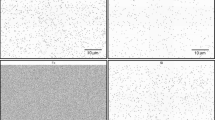Abstract
T91 grade steels showed a gradual enhancement in tensile ductility at ambient temperature due to an increase in Si content from 0.5 to 2.0 weight percent (wt.%). However, the ultimate tensile strength was reduced only above 1.5 wt.% Si. The corrosion potential became more active in an acidic solution with increasing temperature. The cracking susceptibility in a similar environment under a slow-strain-rate (SSR) condition was enhanced at higher temperatures showing reduced ductility, time to failure, and true failure stress. Cathodic potentials applied to the test specimens in SSR testing caused an enhanced cracking tendency at 30 and 60 °C, suggesting hydrogen embrittlement as a possible mechanism of failure. Cracking of precracked and wedge-loaded double-cantilever-beam specimens was enhanced at higher initial stress intensity factors. In general, steels with 2.0 wt.% Si showed inferior corrosion resistance. A combination of cleavage and intergranular brittle failure was seen in the tested specimens depending on the type of testing.










Similar content being viewed by others
References
F. Venneri, M.A. Williamson, N. Li, M.G. Houts, R.A. Morley, D.E. Beller, W. Sailor, G. Lawrence (2000) Disposition of Nuclear Waste using Subcritical Accelerator-Driven Systems: Technology Choices and Implementation Scenarios. Nucl. Technol. 132: 15
A.K. Roy, M.K. Hossain (2005) Environment-Assisted Cracking of Structural Materials Under Different Loading Conditions. Corrosion 61(4): 364
A.K. Roy, M.K. Hossain (2006) Cracking of Martensitic Alloy EP-823 Under Controlled Potential. J. Mater. Eng. Perform. 15(3): 336
T. Hayashi, M. Takamoto, K. Ito, K. Tanaka (2005) The Effect of Nb and W Alloying Additions to the Thermal Expansion Anisotropy and Elastic Properties of Mo5Si3. Met. Mat. Tran. 36A(3): 533
J.L. Boutard, Y. Dai, and K. Ehrlich, MEGAPIE General Meeting
A.M. Huntz, V. Bague, G. Beauplé, C. Haut, C. Sévérac, P. Lecour, X. Longaygue, F. Ropital (2003) Effect of Silicon on the Oxidation Resistance of 9% Cr Steels. Appl. Surf. Sci. 207(1–4): 255
R. Nishimura, K. Yamakawa, J. Ishiga (1998) Highly Corrosion Resistant Stainless Steel with Si Implanted/Deposited Phase. Mat. Chem. Phys. 54(1–3): 289
ASTM Designation E 8-2004, Standard Test Methods for Tensile Testing of Metallic Materials, American Society for Testing and Materials (ASTM) International, 2004
ASTM Designation G 38, Standard Practice for Making and Using C-Ring Stress-Corrosion Test Specimens, American Society for Testing and Materials (ASTM) International, 2001
ASTM Designation G 30, Standard Practice for Making and Using U-Bend Stress-Corrosion Test Specimens, American Society for Testing and Materials (ASTM) International, 1997
NACE Standard TM0177, Laboratory Testing of Metals for Resistance to Sulfide Cracking in H2S Environments, National Association of Corrosion Engineers (NACE), 1990, p 16
ASTM Designation E 399, Standard Test Method for Linear-Elastic Plain-Strain Fracture Toughness K1C of Metallic Materials, American Society for Testing and Materials (ASTM) International, 1999
D. Maitra, Tensile Deformation and Environmental Degradation of T91 Grade Steels with Different Silicon Content, PhD Dissertation, Mech. Eng., UNLV (2007)
A.K. Roy, V. Virupaksha (2007) Performance of Alloy 800H for High-Temperature Heat Exchanger Applications. Mat. Sci. Eng. A 452–453: 665
A.K. Roy, A.V. Kaiparambil (2006) Tensile and Corrosion Behavior of Zr705 for Nuclear Hydrogen Generation. Mat. Sci. Eng. A 427: 320
R. Prabhakaran, A.K. Roy (2006) Degradations of Type 422 Stainless Steel in Aqueous Environments. Mat. Sci. Eng. A 421: 290
ASTM G 5-94, Standard Reference Test Method for Making Potentiostatic and Potentiodynamic Anodic Polarization Measurements, American Society for Testing and Materials (ASTM) International, 1999
B.V.N. Rao, M.S. Rashid (1983) Direct Observations of Deformation-Induced Retained Austenite Transformation in a Vanadium-Containing Dual-Phase Steel Metallography 16: 19
L.C. Covington (1979) The Influence of Surface Condition and Environment on the Hydriding of Titanium. Corrosion 35(8): 378
B. Mintz (2000) Role of Silicon in Influencing Strength and Impact Behavior of Ferrite and its Likely Influence at Ultrafine Grain Size. Struc. Mat. Mat. Cong. 16: 1282
J.M. Rigsbee and P.J. Vanderarend, Formable HSLA and Dual-Phase Steels, New York, TMS-AIME, 1977, p 56
A.K. Roy D.L. Fleming B.Y. Lum, Localized Corrosion Behavior of Candidate Nuclear Waste Package Container Materials, Mat. Perform., 1998, 37, 54
I. Azkarate, A. Pelayo, and L. Victori, Progress in the Understanding and Prevention of Corrosion, vol. 2, 1993, p 1573
Acknowledgment
This work was funded by the United States Department of Energy under grant number DE-FC07-06 ID14781.
Author information
Authors and Affiliations
Corresponding author
Rights and permissions
About this article
Cite this article
Roy, A., Maitra, D. & Kumar, P. The Role of Silicon Content on Environmental Degradations of T91 Steels. J. of Materi Eng and Perform 17, 612–619 (2008). https://doi.org/10.1007/s11665-007-9191-3
Received:
Revised:
Accepted:
Published:
Issue Date:
DOI: https://doi.org/10.1007/s11665-007-9191-3




